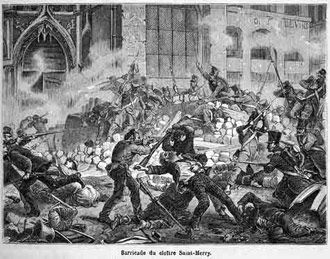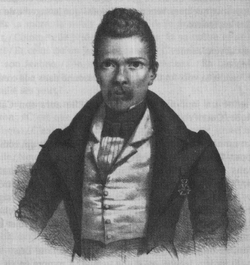Charles Jeanne was a revolutionary during the June Rebellion 1832 in Paris. He was the Commander of the St. Mery barricade and stronghold which was the largest barricade and the last to fall during this event. He and his barricade are mentioned a number of times in the novel Les Misérables during the Rebellion. The tocsin (bell) from the St. Mery Church, which was also taken over by Charles Jeanne’s rebel group was continually ringing through the whole time of the battles.
In the novel it is mentioned that Enjolras and those on his barricade could hear this bell and as long as they heard it, they were reassured that the St. Mery stronghold was still holding out.
History
Charles Jeanne was born in Paris in 1800 and left school at 14 because his parents could no longer afford to keep him there. After this he worked possibly with his father. He then joined the army for some time.
He had been a Republican all his life (“from when I reached the age of reason”). He fought in the July 1830 Revolution where he was wounded. He won the la croix de juillet (the cross of July) for bravery. He was very proud of this decoration and always wore it, he is wearing it in the picture with this article. He was not so happy that though the revolution removed the Bourbon King Charles X, he was immediately replaced by another Bourbon King, Louis-Phillipe.
Not all the Republicans and revolutionaries at this time had the same views. There were those like Charles Jeanne and his followers whose main aim was to depose the King and make France a republic. He also wanted equality and liberty for all and the abolition of monopolies and privileges. He was seen as the “workers leader”.
Then there were those who went further and wanted a complete revolution like the Great French Revolution of 1789 and had Utopian ideas of bringing in a “New World”. The fictional revolutionaries in Les Miserables, Enjolras and his followers were of the second type. Victor Hugo called them Utopians and dreamers. Enjolras and his followers fought under the Red Flag.
Charles Jeanne hated the Red Flag and what it stood for and those who fought under it. He called it “a flag of blood”.
Another group of fighters were the "Legitimists" who wanted to depose King Louis-Philippe and replace him with either former King Charles X or his grandson, who they saw as the legitimate heirs to the throne.
5 and 6 June 1832
At the time of 5 June 1832, Charles Jeanne was a National Guard. Some National Guards were Republicans. The National Guard was a Citizens Militia and most men served in it at some time, either as part-time reserves or permanent full time. It is believed that Charles was a permanent member. In the novel, Jean ValJean is a member of the National Guard.
On 5 June 1832 he went to watch the funeral procession of General Lamarque with other National Guards in uniform and his friends. They had no plans for revolution, as they felt the time was not ready yet. They just wanted to peacefully protest and honour the General. Disorder broke out after a Red Flag was raised and the carriage carrying the coffin was hijacked, and soldiers and Dragoons fired on and charged at innocent citizens, wounding and killing some. He and his friends were enraged, he believed that the Red Flag was raised by police saboteurs to cause unrest among the people and give the soldiers reason to fire on the people.
Jeanne and his followers rushed to erect barricades. They chose the area around the St Mery Church and monastery and had the house no. 30 as their headquarters. They also co-opted the church and monastery as part of their stronghold. Victor Hugo writes: "Within less than an hour twenty-seven barricades had sprung up in the quarter of Les Halles alone. At the centre was the famous house no. 50 [should be 30] which became the fortress of the workers’ leader, Jeanne, and his 106 followers.”

And so started the fighting. Jeanne hoped that regiments of the National Guard would join the rebels, but they didn’t and became their mortal enemies. Men of all ages joined the St Mery barricades; including old soldiers in their sixties and young boys 14-16 years of age. There were also police spies who tried to join, but Jeanne had been warned about the tricks that the police would try. They had a lot support from the householders and residents nearby who brought them powder and cartridges and food. During the night the regular army was called out too. In the early hours of the morning Jeanne realized, after hearing the reports from the young boys he sent out as scouts, that they had no chance of winning and that some of the other barricades had fallen. He told his men that if any wanted to leave and maybe fight another day, they could leave. Only one man left and he later gave evidence for the prosecution at the trials. Charles was wounded during the fighting and after having a bullet painfully dug out of his lower back went straight back to fighting as if nothing had happened.
Finally in the late afternoon of the 6th June, cannons destroyed the barricades, plus the rebels were running low on ammunition. A number of the rebels managed to escape, including Jeanne himself to the safety of nearby houses where the occupants opened their doors to them and others escaped over the roofs. Those rebels who took refuge in the house No. 30 and who had been in there firing from the various floors, surrendered to the regular army. Unfortunately, the National Guards were angry and furious and took the prisoners from the army soldiers and cruelly massacred them with their bayonets, throwing them alive out of the fourth story windows and other things. Jeanne saw this happening from the house where he had been given sanctuary and wanted to rush out and fight, but the householder locked the door and kept the key and reminded Jeanne that if he left the house he would be exposing the hiding place of his comrades with him and the identity of the people who had given them sanctuary. A few hours after the battles ended, he was able to leave the house, and went straight home to bed and had a few hours sleep. He was woken at 5 o’clock in the morning and warned that his house was about to be surrounded by the police. The next day, when in disguise he was among the crowds watching the succession of carts taking the bodies to the morgue, including those of his comrades, he swore that if he was ever in a fight with the National Guard again he would never leave one alive. He again had to be held back from attacking the National Guards accompanying the carts. He had his gun under his clothes. The morgue overlooked the River Seine and Georg Sand the author who lived on the other side of the river from the morgue, wrote in a letter to a friend that “there was a red stripe of blood in the river under the morgue”.
After the Fall of the Barricade and Imprisonment
Charles Jeanne went on the run for four months until he was betrayed by someone who he thought was a friend. The worst thing for him during this time was that he couldn’t contact or see his parents, whom he was very close to and who supported him completely. His parents’ house was closely watched and frequently searched by the police and they were followed by the police whenever they went out.
In October 1832 he went on trial as one of the twenty-two St Mery rebels facing the court. Here is an official description of him at the time: “This accused is small, he is thin and pale; his attitude is that of a man of resolution; in his buttonhole is a decoration of July; a tricolor cockade is on his hat.” Some of the rebels claimed that they weren’t there or they were there by accident and never fired a shot or were forced to take part. Charles never denied anything and had plenty to say, as did his lawyer. His parents were there every day of the trial, his mother wrote him a letter while he was on trial, telling him how proud she was of him and how proud she was to be his mother.
He was found guilty and jailed as a political prisoner. In France in those days there were different sections of prisons for political prisoners and for ordinary criminals. Political prisoners had slightly better conditions. Not that being in jail stopped him and the other rebels from agitating. They complained about the conditions in the jail, about the food and wine they were given. They wrote letters to newspapers and the authorities. They were allowed visits from their families; Charles’ parents visited him regularly. He was moved around to many different jails in the nearly five years he was imprisoned. Whether he caught tuberculosis in prison where it was common, or he already had it when he was jailed is not known. He was in prisons at Sainte-Pélagie, Mont Saint-Michel (the island prison), Bicêtre, Clairvaux, Doullens. He never stopped his political activities while in jail.
Death
In May 1837 King Louis-Philipe declared a Royal Amnesty for political prisoners notably those imprisoned because of the June 1832 Rebellion. Unfortunately, Charles Jeanne was dying from TB by then and would only live another two months. Whether he died actually in the prison or spent the last two months of his life living in the town with his family is not known. He died in Doullens on 11 July 1837 aged 37. The inhabitants of the town followed his funeral convoy.
